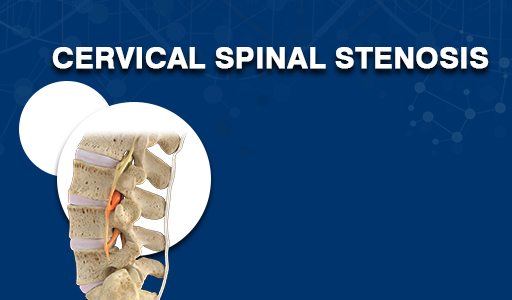


Stenosis means narrowing of a structure and cervical spinal stenosis refers to the narrowing or tightening of the spinal canal in the neck. The spinal canal is the bony tube in which the spinal cord and the nerve roots travel to our arms and legs. It’s narrowing can lead to pinching, squeezing, and compression of the nerve roots or can also damage the spinal cord itself. Eventually, the person will show various symptoms like pain, stiffness, and incontinence.
Cause of Cervical Stenosis
Cervical spinal stenosis is a slow and progressive disorder that is usually caused due to age-related degeneration in the shape and size of the spinal canal. It most commonly occurs in people older than 50 years. Other than this, the main causes of cervical stenosis include the following:
• Overgrowth of bone due to osteoporosis
• Herniated disks
• Stiff and thickened ligaments
• Tumor
• Spinal injuries/trauma
• Congenital (narrow spinal canal by birth)
NA
Symptoms of Cervical Stenosis
Some patients may have narrowed spinal canal only as a finding noted on X-ray or MRI but do not have symptoms. This is because symptoms usually appear over a long period when the spinal cord or nerves become squeezed. Symptoms may include:
• Pain and stiffness in the neck, shoulders, arms, hands, or legs
• Neurological symptoms like numbness, weakness, or tingling in a leg, foot, arm, or hand
• Headache
• Balance and coordination problems especially while walking
• Heavy feeling in the legs
• Incontinence (loss of bowel or bladder control)
• If left untreated, it may also lead to paralysis
Diagnosis of Cervical Stenosis
Diagnosis of cervical stenosis starts with a complete history along with a thorough physical and neurological examination of the patient. This will give a good idea about the problem to the physician. But to make sure of the exact diagnosis, several diagnostic tests are carried out including:
• X-rays
• Magnetic Resonance Imaging (MRI)
• CT myelogram (in case MRI is not possible)
The treatment you need for your spinal stenosis depends on where the stenosis is and how severe your symptoms are. You might need:
Medication
You might take:
Over the counter pain treatment: Common pain remedies such as aspirin, acetaminophen (Tylenol), ibuprofen (Advil, Motrin), and naproxen can offer short-term relief. All are available in low doses without a prescription.
Antidepressants: Taking tricyclic antidepressants, such as amitriptyline, can help ease chronic pain.
Opioids: For short-term pain relief, your doctor might prescribe drugs with codeine, such as oxycodone (Oxycontin, Roxicodone) and hydrocodone (Norco, Vicodin). These drugs can be habit-forming and have serious side effects.
Muscle relaxants: These can help control muscle spasms.
Anti-seizure medication: You can take these to ease pain from damaged nerves.
Corticosteroid injections: Your doctor will inject a steroid such as prednisone into your back or neck. Steroids make inflammation go down. However, because of side effects, they are used sparingly.
Anesthetics: Used with precision, an injection of a “nerve block” can stop pain for a time.
Surgery
If you have a severe case of spinal stenosis, you might struggle to walk or have issues with your bladder and bowels. Your doctor may recommend a type of surgery to create space between the bones so inflammation can go down. You might get:
Laminectomy. This procedure removes the back part of the affected vertebrae.
Laminoplasty. Your doctor puts metal hardware in your neck vertebrae to form a bridge in the open section of your spine.
NA
